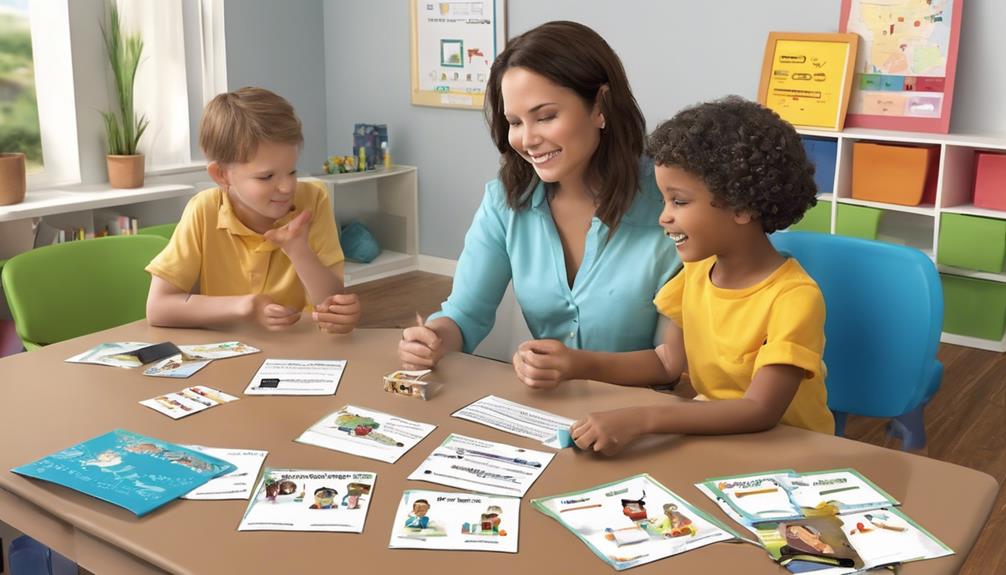As we navigate the realm of cognitive speech therapy techniques, it's fascinating to note that research has shown a significant correlation between the application of these methods and a notable improvement in communication skills.
From mindfulness practices to executive functioning exercises, the landscape of strategies available is vast and impactful.
So, how exactly do these techniques work their magic in enhancing our ability to connect and express ourselves effectively? Let's explore the intricate web of cognitive interventions that pave the way for improved communication prowess.
Key Takeaways
- Mindfulness techniques enhance present moment awareness and active listening, improving communication focus.
- Response-Elaboration Training (RET) encourages detailed responses, expanding expressive language and communication skills.
- Memory enhancement strategies like visualization and association methods aid in memory recall for improved communication.
- Cognitive speech therapy develops executive functioning, independence, and cognitive skills crucial for effective communication.
Mindfulness Techniques for Communication Improvement
Mindfulness techniques play a pivotal role in enhancing communication skills by fostering present moment awareness and promoting active listening abilities. By incorporating mindfulness practices into cognitive speech therapy, individuals can better focus on their thoughts, feelings, and surroundings during interactions. This heightened sense of present moment awareness allows for a deeper connection with others and a reduction in distractions that may hinder effective communication. Active listening skills are also improved through mindfulness, as individuals learn to truly engage with what's being communicated without judgment or preconceived notions.
Moreover, mindfulness techniques increase self-awareness, enabling individuals to better understand their own communication patterns and how they may be perceived by others. This self-awareness is crucial for improving overall communication effectiveness and fostering meaningful connections with those around us. Through mindfulness, therapy sessions can become more engaging, leading to better understanding and connection in social interactions.
Cognitive Restructuring Exercises for Better Expression

As we explore cognitive restructuring exercises for better expression, it's crucial to identify thought patterns, challenge negative beliefs, and practice positive self-talk.
By recognizing and addressing unhelpful cognitive patterns, individuals can significantly enhance their communication skills.
Engaging in exercises that promote positive thinking can lead to clearer and more effective expression in various communication contexts.
Identify Thought Patterns
How can cognitive restructuring exercises assist individuals in enhancing their communication skills by identifying and altering negative thought patterns?
Cognitive restructuring techniques play a crucial role in improving communication effectiveness by addressing distorted thinking patterns. Through exercises that help identify negative thought patterns, individuals can work towards fostering healthier social interaction skills and clearer self-expression.
By recognizing and challenging irrational beliefs, individuals can enhance their communication habits, leading to reduced misunderstandings and more positive interactions. Engaging in cognitive restructuring not only aids in pinpointing areas for improvement but also in developing strategies to overcome communication obstacles.
Thought pattern identification is a key step in the process of enhancing communication skills and promoting more effective interpersonal relationships.
Challenge Negative Beliefs
What cognitive restructuring exercises can individuals engage in to challenge and transform negative beliefs for improved expression and communication skills?
Cognitive speech therapy techniques focus on challenging negative beliefs through activities that help identify and replace distorted thinking patterns. By encouraging individuals to confront and reframe negative thoughts into positive statements, therapy sessions aim to enhance self-expression.
Through cognitive restructuring exercises, individuals can boost confidence, reduce anxiety, and develop clearer communication abilities. It's essential to recognize how negative beliefs impact communication skills and actively work towards transforming them into more constructive perspectives.
Practice Positive Self-Talk
Practicing positive self-talk in cognitive speech therapy involves transforming negative thoughts into affirmations that enhance communication skills and confidence. By engaging in cognitive restructuring exercises, individuals can challenge and replace unhelpful thoughts with constructive and supportive ones, leading to improved communication abilities. This process not only boosts confidence but also aids in anxiety reduction, allowing for clearer and more assertive expression. Moreover, fostering a mindset of empowerment through positive self-talk facilitates better communication outcomes overall.
| Cognitive Restructuring Exercises | Benefits |
|---|---|
| Challenge negative thoughts | Enhances communication skills |
| Replace with positive affirmations | Boosts confidence |
| Reduce anxiety | Improves self-expression |
| Empower mindset | Facilitates better outcomes |
| Enhance communication skills | Promotes clear expression |
Response-Elaboration Training (RET) Benefits

Response-Elaboration Training (RET) offers significant benefits in improving communication skills by encouraging individuals to provide detailed responses.
Through RET techniques, individuals can enhance their expressive language abilities and expand their communication skills.
RET Techniques Overview
In cognitive speech therapy, the benefits of Response-Elaboration Training (RET) become evident through the enhancement of individuals' communication skills by encouraging detailed and elaborate responses. RET is a technique that aims to improve communication skills, especially for individuals with cognitive-communication disorders.
By engaging in structured practice sessions that prompt individuals to expand on their responses, RET helps develop better communication habits. This technique enables individuals to convey information effectively by providing more elaborate answers to questions or prompts.
Through consistent practice of RET techniques, individuals can enhance their ability to express themselves clearly and efficiently in various communication settings. RET plays a crucial role in improving communication habits and fostering better communication skills among individuals with cognitive-communication disorders.
Practical Application Tips
To capitalize on the benefits of Response-Elaboration Training (RET) in cognitive speech therapy, practical application tips offer valuable insights into enhancing communication skills by encouraging detailed and comprehensive responses.
When implementing RET in therapy sessions for individuals with cognitive-communication disorders, focusing on practical applications can significantly improve expressive language skills and overall communication effectiveness.
Here are some practical application tips for incorporating RET effectively:
- Encourage individuals to elaborate on their responses by asking open-ended questions that require detailed answers.
- Provide prompts or cues to guide individuals in expanding their responses and expressing thoughts more fully.
- Offer positive reinforcement and praise when individuals successfully provide detailed and comprehensive responses, reinforcing the use of RET techniques.
Enhancing Communication Through Naming Therapy

Enhancing communication through Naming Therapy involves structured exercises aimed at improving word retrieval and naming abilities in individuals with cognitive-communication disorders such as aphasia, dysarthria, or speech disorders. This therapy targets specific techniques like semantic feature analysis, phonological cueing, and repetition to aid in word retrieval.
By honing these skills, individuals with aphasia, dysarthria, or other speech impairments can enhance their ability to express themselves effectively. Naming Therapy not only focuses on the surface level of naming objects but also delves deeper into the semantic associations of words to facilitate better communication.
Consistent practice and dedication to Naming Therapy can yield significant improvements in naming and word-finding difficulties, ultimately leading to enhanced communication skills. It's essential for therapists and individuals undergoing this therapy to work collaboratively to maximize the benefits and promote long-term progress in communication abilities.
Task Sequencing for Improved Speech Skills

When practicing task sequencing in cognitive speech therapy, we focus on organizing steps in a specific order to enhance speech skills. This technique helps us structure our thoughts and speech production by breaking tasks into manageable sequences.
Order in Speech
In cognitive speech therapy, mastering task sequencing plays a pivotal role in honing speech skills and fostering effective communication abilities. Task sequencing involves organizing steps logically to enhance speech skills, particularly for individuals with cognitive-communication disorders.
Here are key points about the importance of order in speech:
- Enhanced Communication: Task sequencing activities help individuals follow directions and communicate more effectively.
- Cognitive Skill Development: These exercises focus on improving memory, attention, and problem-solving skills, crucial for speech clarity and coherence.
- Executive Functioning: Practice with task sequencing enhances organizational abilities in speech production, aiding in planning, organizing, and executing speech-related tasks accurately.
Sequential Skill-building
Task sequencing in cognitive speech therapy serves as a foundational technique aimed at improving cognitive and speech skills by organizing activities in a specific order. This method enhances cognitive flexibility, problem-solving skills, memory, attention, and executive functioning crucial for effective communication.
By engaging in sequential skill-building exercises, individuals can strengthen their ability to plan, organize, and execute speech-related tasks. Through structured task sequencing, clients practice coordinating their thoughts and actions, leading to better communication outcomes.
This fundamental approach in cognitive speech therapy provides a systematic way to train individuals in the skills necessary for successful communication. As individuals progress through tasks in a logical sequence, they develop essential cognitive and speech abilities that contribute to improved overall communication proficiency.
Spaced Retrieval Techniques for Memory Enhancement

Utilizing the spaced retrieval technique in cognitive speech therapy enhances memory retention by reinforcing memory traces over time. This structured method is particularly beneficial for individuals with cognitive impairments as it promotes information retention through spaced practice and repetition.
Here are three key aspects highlighting the effectiveness of spaced retrieval techniques for memory enhancement:
- Recalling Information: Spaced retrieval involves recalling information at increasing intervals, leading to improved memory recall even for individuals with cognitive impairments.
- Long-Term Memory Storage: By promoting spaced practice and repetition, this technique aids in long-term memory storage, ensuring that information is retained over time.
- Reinforcement of Memory Traces: Spaced retrieval reinforces memory traces, strengthening the connections in the brain and facilitating better memory retention, a crucial aspect of cognitive speech therapy.
Rhythm Matching for Speech Fluency

Enhancing speech fluency through the practice of rhythmic patterns is a fundamental component of cognitive speech therapy techniques. Rhythm Matching, a technique within cognitive speech therapy, focuses on improving speech fluency by matching rhythmic patterns provided by a therapist or a tool. This method helps individuals with speech fluency disorders, such as stuttering, achieve smoother and more controlled speech. By engaging in Rhythm Matching activities, individuals work on regulating speech rate and enhancing overall communication clarity. Through consistent practice, individuals can develop better control over their speech flow, leading to reduced disruptions in their communication.
| Benefits of Rhythm Matching | ||
|---|---|---|
| Improves Speech Fluency | Enhances Communication Clarity | Regulates Speech Rate |
Incorporating Rhythm Matching into cognitive speech therapy sessions can significantly benefit individuals seeking to improve their speech fluency and overall communication skills. This technique offers a structured approach to enhance speech pacing and control, aiding individuals in managing speech disorders and achieving more fluent communication.
At-Home Practices for Cognitive Speech Therapy

Consistent practice of cognitive speech therapy exercises at home plays a crucial role in enhancing communication skills, particularly following a brain injury. Engaging in at-home practices can significantly contribute to the speed of recovery and the improvement of cognitive and communication abilities. Here are three key ways at-home practices for cognitive speech therapy can benefit individuals:
- Enhanced Neuroplasticity: Regular at-home cognitive speech therapy exercises help promote neuroplasticity, the brain's ability to reorganize and form new neural connections. This rewiring process is crucial for recovering communication skills post-brain injury.
- Supplementing Outpatient Therapy: Individuals attending outpatient therapy sessions once a week may not receive enough repetition to maximize recovery. Supplementing these sessions with daily at-home cognitive speech therapy exercises can fill this gap and accelerate progress.
- Accelerated Recovery: By incorporating daily cognitive speech therapy activities at home, survivors of traumatic brain injuries can speed up the restoration of cognitive and communication skills, leading to improved overall quality of life.
Understanding the Role of Speech Language Pathologists

Speech-language pathologists, with their specialized training and expertise, play a crucial role in evaluating and addressing cognitive-communication disorders. These professionals design personalized treatment plans tailored to each individual's specific communication and cognitive challenges.
By collaborating with clients, families, and healthcare professionals, speech-language pathologists provide holistic care, ensuring all aspects of the individual's well-being are considered in the treatment process. With a bachelor's degree in healthcare and a master's degree in speech-language pathology, they're well-equipped to work closely with individuals to enhance their communication skills and cognitive abilities.
Through regular sessions and targeted interventions, speech-language pathologists help individuals improve their overall quality of life by fostering effective communication and strengthening cognitive functions. Their dedication to creating individualized strategies underscores their commitment to maximizing each person's potential for successful communication and cognitive development.
Memory Strategies for Effective Communication

Memory strategies play a vital role in cognitive speech therapy by enhancing retention through repetition, visualization, and association techniques. These strategies are essential for addressing memory challenges and improving communication skills. Here are three key aspects of memory strategies in cognitive speech therapy:
- Retention Enhancement: Memory strategies aim to enhance retention by reinforcing information through repeated practice. This helps individuals remember details, instructions, and conversations more effectively during communication.
- Visualization Techniques: Utilizing visualization techniques involves creating mental images to aid in memory recall. By associating information with visual cues, individuals can strengthen their ability to remember and communicate information clearly.
- Association Methods: Association techniques involve linking new information with existing knowledge to improve memory recall. By forming connections between concepts, individuals can enhance their memory capacity and facilitate smoother communication.
Executive Functioning Exercises for Better Cognitive Abilities

Upon mastering memory strategies for effective communication, individuals can further enhance their cognitive abilities through executive functioning exercises in cognitive speech therapy. These exercises target key executive functioning skills such as planning, organization, time management, self-regulation, and problem-solving. By engaging in activities that promote these skills, individuals learn how to break down complex tasks, set achievable goals, and effectively manage their time. Moreover, honing executive functioning abilities can lead to improved cognitive flexibility and enhanced problem-solving capabilities.
In cognitive speech therapy, exercises focusing on executive functioning help individuals prioritize tasks, make better decisions, and boost their attention spans. Strengthening these skills is vital for enhancing overall cognitive abilities and communication skills. Training in executive functioning not only aids in day-to-day tasks but also plays a significant role in promoting independence and long-term cognitive health. Through targeted exercises and strategies, individuals can cultivate these essential skills to navigate various cognitive challenges effectively.
Compensatory Strategies for Lasting Independence

Utilizing tailored compensatory strategies plays a crucial role in fostering lasting independence and improving communication effectiveness in cognitive speech therapy. These customized techniques are designed to address specific communication challenges individuals face, ultimately enhancing their quality of life and cognitive function. Here are three key points to consider:
- Addressing Communication Challenges: Compensatory strategies offer alternative methods such as gestures, writing, or specialized communication devices to help individuals overcome barriers in effective communication.
- Promoting Independence: By providing tools and techniques to compensate for communication difficulties, these strategies empower individuals to engage more independently in various social interactions and daily activities.
- Enhancing Quality of Life: Customized compensatory strategies aim to improve the overall quality of life by enabling individuals to communicate effectively, fostering meaningful connections, and enhancing their cognitive abilities for long-lasting independence.
Frequently Asked Questions
What Are the Cognitive Aspects of Communication Speech Therapy?
When discussing the cognitive aspects of communication speech therapy, we focus on memory, attention, problem-solving, and executive functioning skills. These elements are crucial for effective communication outcomes.
Memory retention strategies like repetition and visualization help enhance information recall. Attention enhancement exercises improve listening skills and following directions. Problem-solving abilities are honed through cognitive-linguistic exercises targeting logical thinking.
Executive functioning and social skills training enhance planning, organization, time management, and collaboration for better communication.
What Is the Cognitive Approach to Effective Communication?
We believe that the cognitive approach to effective communication involves enhancing cognitive abilities like memory, attention, and problem-solving to boost communication skills.
By focusing on improving these cognitive functions, individuals can better express themselves and understand others. This technique aims to stimulate brain healing and function restoration through tailored exercises and strategies.
It plays a crucial role in addressing communication challenges and promoting neuroplasticity for improved speech and language abilities.
Can Speech Therapy Improve Communication Skills?
Yes, speech therapy can improve communication skills by targeting articulation, comprehension, and pragmatic language. It enhances memory, attention, sequencing, and categorization for better problem-solving.
Training in executive functioning and social skills aids in planning, organization, time management, and collaborative problem-solving. Activities involve task breakdown, goal-setting, and time management practice.
Techniques like role-playing, perspective-taking, and emotional regulation strategies boost social skills and communication proficiency.
What Is the Treatment for Cognitive Communication Disorders?
In treating cognitive communication disorders, we utilize cognitive speech therapy techniques that target memory, attention, problem-solving, and reasoning abilities.
By employing methods like Response-Elaboration Training (RET), Naming Therapy, and Task Sequencing, we aim to address cognitive communication impairments.
These activities stimulate neuroplasticity and aid in restoring cognitive and communication function post-injury.
Our personalized treatment plans incorporate high repetition exercises to assist individuals in enhancing their communication skills.
Conclusion
In conclusion, cognitive speech therapy techniques are like a symphony orchestra, harmoniously working together to improve communication skills.
From mindfulness techniques to memory strategies, each method plays a unique role in enhancing cognitive abilities.
With the guidance of speech language pathologists, individuals can unlock their potential for better expression and social interaction.
By incorporating these techniques into daily practice, one can experience a transformative journey towards lasting independence and improved communication skills.











